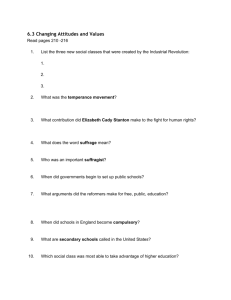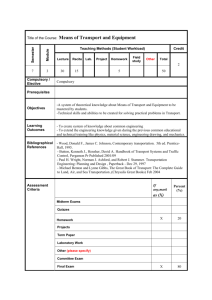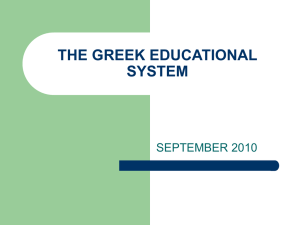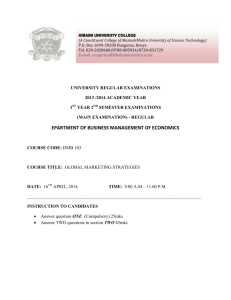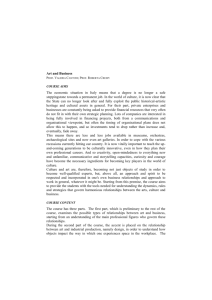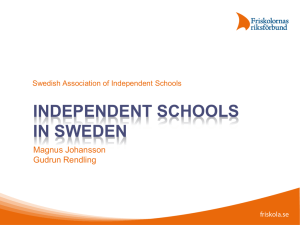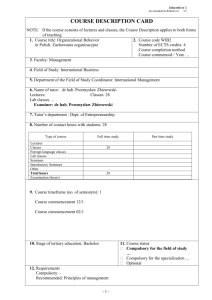A presentation about the Swedish education system
advertisement
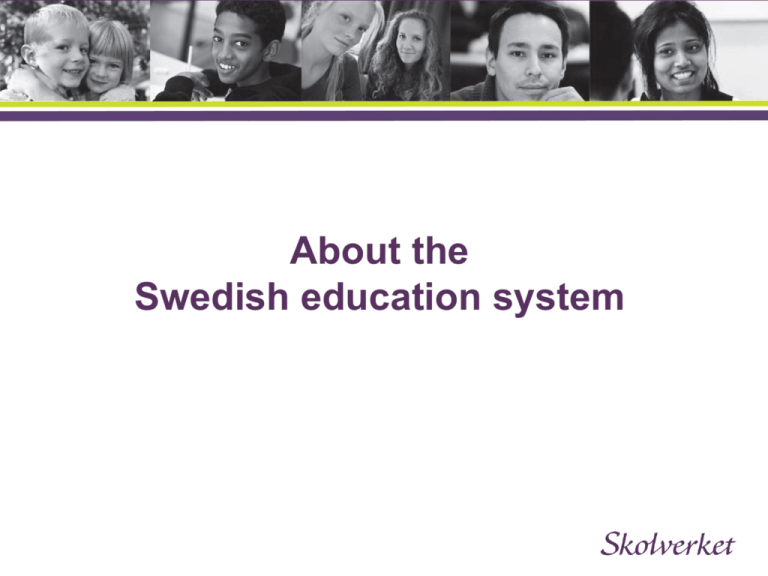
About the Swedish education system Det svenska utbildningssystemet How are the preschool and school steered? A goal steered system with a high degree of local responsibility. The main responsibility lies with the municipalities and the organisers of independent schools and schools. The Swedish Riksdag and the government draw up the overall national goals in: • The Education Act • The curricula • The school ordinance, the upper secondary school ordinance, and the adult education ordinance • The syllabuses for compulsory school • The subject syllabuses for the upper secondary foundation subjects • The diploma goals for the upper secondary school The Agency's steering instruments The National Agency for Education draws up and decides on: • Syllabuses for the compulsory school, the compulsory school for learning disabilities, the Sami school and the special school • Subject syllabuses for the upper secondary school • Knowledge requirements for all school forms • Regulations • General guidelines School organisers have primary responsibility for distributing resources and organising activities so that pupils attain the national goals. Based on this, each preschool, school and leisure-time centre chooses the working approaches most appropriate for them. The work is followed up by means of systematic quality assessment. Grading scale In the compulsory school for learning disabilities, grades are only awarded if the pupil, or the pupil's guardian requests this. F or a (–) dash are not used in the compulsory school for learning disabilities. Pass level Preschool • New as a school form for children aged 1-6 years. • Voluntary, general preschool from the age of 3, or from the age of 1 if this is needed because of parents' work or studies or the child's own needs. • Should ”stimulate the child's development and learning, and also provide a secure care environment." Preschool class • Voluntary school form, free of charge for children aged six. • Covers a minimum of 525 hours per school year. • Should ”stimulate pupils' development and learning and prepare them for further education.” • Combines the working approaches and methods of the preschool and school. Compulsory school education • Compulsory school attendance starts when the child reaches the age of seven. • Compulsory school attendance is the norm in compulsory school. • Compulsory schools are run by municipal or private organisers. Alternatives to the compulsory school • The compulsory school for pupils with learning disabilities, sometimes together with the training school, has its own curriculum and syllabuses, for years 1 - 9 with the option of an additional year. • The special school (state), 5 regional schools - hearing, 3 national schools, years 1 - 10. • The Sami school (state), years 1-6. • There are also other options, e.g. 7 international schools, 3 national boarding schools, special # youth homes and Swedish schools abroad. Leisure-time centres • Supplements the school for pupils aged between 6-13 years. • Should ”stimulate pupils' development and also provide them with meaningful recreational activities.” • ”… to the extent needed with regard to parents' work or studies, or the pupil's own needs.” The upper secondary school • All pupils who have completed compulsory schooling are offered upper secondary education by their home municipality. • The right to start an upper secondary education applies to students up to the age of 20. • The upper secondary school is free of charge and voluntary. • Starting upper secondary school means that students accept the rules governing absenteeism and participation in the education. Admission requirements Vocational programmes • Pass grades in • Swedish or Swedish as a second language • English • Mathematics • Five other compulsory school subjects Higher education preparatory programmes Pass grades in • Swedish or Swedish as a second language • English • Mathematics • Eight other compulsory school subjects Education in upper secondary school Vocational programmes/ Apprenticeship education Higher education preparatory programmes • • • • • • • • • • • • • Child and Recreation Building and Construction Electricity and Energy Vehicle and Transport Business and Administration Handicraft Hotel and Tourism Industrial technology Natural Resource Use Restaurant Management and Food HVAC and Property Management Health and Social Care • • • • • Business Management and Economics Arts Humanities Natural Science Social Science Technology Introductory programmes • • • • • Preparatory education Programme oriented individual options Vocational introduction Individual alternative Language introduction Nationally determined differences • Special variants • Education with nationwide admission with its own diploma goals • Leading-edge education • Professional dance education • Sports education Diploma goals Programme specialisations Orientation Diploma project Upper secondary foundation subjects Individual options Programme specific subjects Alternatives to the upper secondary school • Upper secondary school for learning disabilities (new as of 2013) • International schools • National boarding schools • IB education • Distance education at upper secondary level in Torsås • Special institutions (state) • (Swedish schools abroad) Municipal adult education • Basic adult education from the age of 20. • Upper secondary municipal adult education from the age of 20 or completion of a national programme or equivalent education. • Special education for adults. • Swedish tuition for immigrants (SFI). • Students from vocational programmes have the right to attain basic eligibility for higher education.
